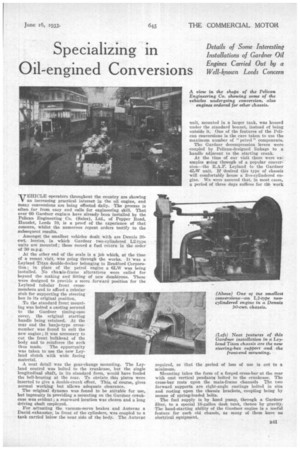Specializing in Oil-engined Conversions
Page 59

If you've noticed an error in this article please click here to report it so we can fix it.
VEHICLE operators throughout the country are showing an increasing practical interest in the oil engine, and many conversions are being effected daily. 'The process is nften far from easy and calls for engineering skill. That over 60 Gardner engines have already been installed by the Pelican Engineering Co. (Sales), Ltd., of Pepper Road, Hunslet, Leeds 10, is a proof of the experience of that concern, whilst the numerous repeat orders testify to the subsequent results.
Amongst the smallest vehicles dealt with are Dennis 30Cwt. lorries, in which Gardner two-cylindered L2-type units are mounted; these record a fuel return in the order of 30 m.p.g.
At the other end of the scale is a job which, at the time of a recent visit, was going through the works. It 'was a Leyland Titan double-decker belonging to Bradford Corporation; in place of the petrol engine a 6LW was being installed. No ebavis-fratne alterations were called for beyond the making and fitting of new dumbirons. These were designed to provide a more forward position for the Leyland tubular front crossmembers and to afford a tubular stub for supporting the steering box in its original position.
To the standard front mounting was bolted a casting secured to the Gardner timing-ease cover, the original starting handle being retained. At the roar end the banjo-type crossmember was found to suit the new engine ; it was necessary to cut the front bulkhead of the body and to reinforce the arch thus made. The opportunity was taken to use the new Leyland clutch with wide facing material.
A neat detail was the gear-change mounting. The Leyland control was bolted to the crankcase, but the single longitudinal shaft, in its standard farm, would have fouled the bell-housing at the rear. To obviate this plates were inserted to give a double-crank effect. This, of course, gives normal working hut allows adequate clearance.
The original dynamo was found to be suitable for use, btrt ingenuity in providing a mounting on the Gardner crankcase was evident ; a rearward location was ehoSen and a long driving shaft employed.
For a0uating the vacuum-servo brakes and Autovac David exhauster, in front of the cylinders, was coupled to a tank carried below the near side of the body. The Autovac unit, mounted in a larger tank, was housed under the standard bonnet, instead of being outside it. One of the features of the Pelican conversions is the care taken to use the maximum number of "petrol" components. The Gardner decompression levers were coupled by Pelican-designed linkage ta a handle adjacent to the starting crank.
At the time of our visit there were ex-: ainples going through of a popular conversion—the R.A.F. Leyland to the Gardner 4LW unit. If desired this type of chassis will comfortably house a five-cylindered engine. We were assured that, in most cases, a period of three days suffices for the work
required, so that the period of loss of use is cut to a minimum.
Mounting takes the form of a forged cross-bar at the rear with cast vertical pendanta bolted to the crankcase. The cross-bar rests upon the main-frame channels The two forward supports are right-angle castings bolted in situ and resting upon the chassis brackets, coupling being by means of spring-loaded halts.
The fuel supply is by hand pump, through a Gardner filter, to a special 16-gallon dash tank, thence by gravitY: The hand-starting ability of the Gardner engine is a useful feature for such old chassis, as many of them have no electrical equipment.






































































































